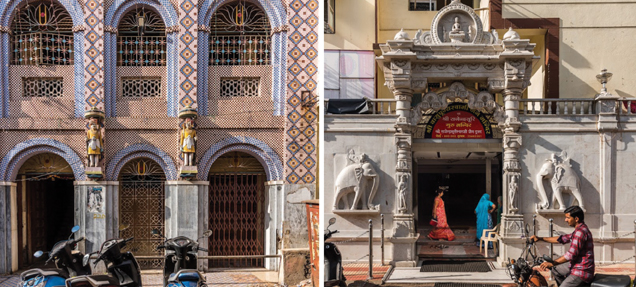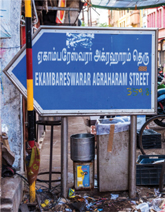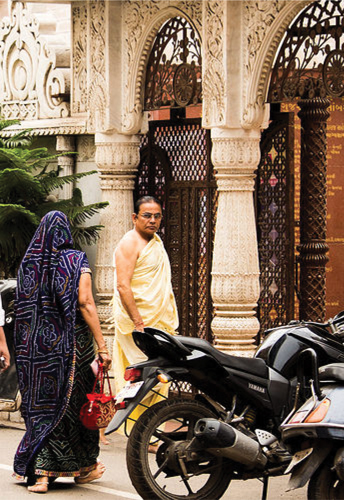Registered with the Registrar of Newspapers for India under R.N.I 53640/91
Vol. XXVIII No. 5, June 16-30, 2018
A virtual walk through Sowcarpet
- Vijaysree Venkatraman

by G.V. Balasubramaniam

Ghosh’s inspiration
Sowcarpet is often described as Chennai’s “Little North India,” in tourist book style. Bustling and bazaar-like, this old neighbourhood is not too far from the city’s iconic Central Station. The area has the city’s first Jain temples, shops, and eateries offering north Indian foods and delicacies. Its lanes are narrow, except for Mint Street, and the area is best explored by foot.

The sowcar in the name of this neighbourhood comes from the Hindi word sahukaar, merchant or native banker, which now refers to a money-lender. In Madras Rediscovered, city chronicler S. Muthiah writes that the diamond and silk merchants, who gave Sowcarpet its name, arrived in the 18th Century from Gujarat. Other settlers, such as the Marwaris from Rajasthan, arrived later. But the original Gujarati immigrants from Saurasthra came in the 17th Century via Madurai and Tirunelveli where they had already established themselves as a weaving community.
These are interesting facts, no doubt, but the atmosphere and the soul of a place are often better understood through fiction. If you want to know more about the life of the Gujarati immigrants, read the short stories written by renowned Tamil author Dilip Kumar. He was born in a Gujarati-speaking family in Coimbatore, but his maternal uncle lived in Sowcarpet. He knew what made the neighbourhood tick. He’d visited the place as a boy, and, later, as a young man looking for work in the city.
Back in the 1970s, for anyone with literary ambitions in Tamil, Madras was the place to be. In which other Indian city would a regional language writer when asked “Have you read Jean Paul Sartre?” come back with, “Why don’t you ask Sartre if he has read me?” (This was the Tamil writer D. Jayakanthan, Dilip Kumar’s early idol with whose writing he grew disillusioned later.)
At the age of 28, Dilip Kumar moved to the metropolis where he’d make his mark as a writer, translator-promoter, and exporter of modern Tamil literature. Today, he is an acknowledged authority on contemporary Tamil fiction, sought after by universities abroad for his expertise on the topic.
The author’s improbable literary career took off when an early work, Theervu, (The Solution) won The Best Tamil Short Story of the Year award for 1977. The story was set in the Gujarati locality close to the Ekambareswarar Temple on Mint Street. The temple, which came up in the 1680s, had been raised by Alanganatha Pillai, a dubash with the British East India Company. “Like the city’s other famous temples, this one appears quite ordinary to its habitués, and magnificent to infrequent visitors,” Dilip Kumar wrote of the historic temple and set the stage for his early stories.
In this neighbourhood called Ekambareswarar Agraharam, you will run into stereotype-shattering characters. Not all the Gujaratis here are saits or wealthy merchants with money to hoard (or lend) – some even hold ordinary government jobs. True, Mittu Mama, a 70-year-old foodie, a protagonist of three excellent stories, was once a well-to-do businessman. Even in his newly-straitened circumstances, he displays an appetite for life, a heart-warming exuberance. Gangu Patti is not an average religious old woman, though she can prescribe rituals for anything which affects a woman’s domestic bliss. The well-read widow, with her piquant talk, is beloved of the many younger residents in the building who seek her counsel.
Even some minor characters in the Agraharam are well-etched. For instance, take Suri, the well-dressed loafer and bi-lingual curser. He metes out justice with his stick – whether the wrong-doer is Tamil or Gujarati makes no difference to him. There is the miserly Jeevanlal who refuses to pay for the treatment of the dhobi’s donkey which broke the possibly fatal fall of his kite-flying 8-year-old son. Suri should “reason” with Jeevanlal, you begin to think. The stories give you a sense of being inter-connected though, except for Mittu Mama, no character appears in more than one story.
Dilip Kumar’s realistic fiction is never dispiriting – so don’t be surprised if you’ll find yourself guffawing right in the middle of an insightful short story. His works have been translated into many Indian and European languages. You’ll also find a Sowcarpet-based short story in each of the two Chennai-themed anthologies, The Unhurried City and Madras on your Mind.
If you do choose to visit Sowcarpet after reading the stories, don’t look for Dilip Kumar’s residence there. The 67-year-old litterateur lives, with his wife Ambika in a flat in a shaded cul-de-sac in Mandaveli. Avid readers, they seem to be adherents of the credo of simple living, high thinking. Their drawing room is quiet, library-like. Overall, the ambience here is quite different from the downtown neighbourhood which inspired the author’s first bout of creativity.

